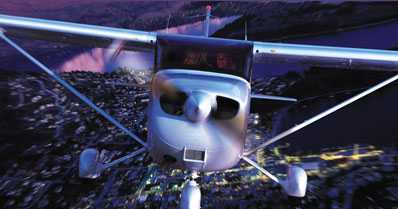Tue, Jun 16, 2009
NTSB Releases Probable Cause Report
 The NTSB has released its probable cause report for a mid-air
collision in January, 2008 which killed four people in two aircraft
and one on the ground. The incident, which happened January 20th of
last year, involved a Cessna 150, piloted by 24-year-old
Anthony Guzman, and a Cessna 172, flown by 73-year-old Paul Carson.
Both pilots were instrument rated, though the accident happened
under VFR conditions.
The NTSB has released its probable cause report for a mid-air
collision in January, 2008 which killed four people in two aircraft
and one on the ground. The incident, which happened January 20th of
last year, involved a Cessna 150, piloted by 24-year-old
Anthony Guzman, and a Cessna 172, flown by 73-year-old Paul Carson.
Both pilots were instrument rated, though the accident happened
under VFR conditions.
The NTSB found:
A Cessna 172N and a Cessna 150M collided in-flight while
maneuvering 1.4 miles southwest of the uncontrolled airport during
day visual meteorological conditions. The midair collision occurred
about 2 minutes after the Cessna 150M had taken off from runway 25,
turned crosswind, and was entering on the downwind leg.
Radar data shows that during this time, a Cessna 172N completed
a course change maneuver and was proceeding inbound toward the
airport on a 034-degree true course, which approximated the
45-degree traffic pattern's entry path to the downwind leg. The
north-northeast-bound Cessna 172N impacted the right side of the
southeast-bound Cessna 150M after the airplanes were flying on
converging courses for about 13 seconds. The collision angle was
about 70 degrees. The four occupants in the airplanes and one
person on the ground were killed.
Calculations based on radar data show that the Cessna 150M pilot
turned onto the crosswind leg prior to reaching 700 feet above
ground level, which is contrary to the Federal Aviation
Administration's recommended procedures. A visibility study
determined that while on the crosswind leg and during the turn onto
the downwind leg, the Cessna 150M pilot had 14-second window of
opportunity to observe the approaching Cessna 172N, which was
travelling at 106 knots (ground speed), but was likely not able to
see it in the final 9 seconds prior to the collision as the Cessna
150 was turning left onto the downwind leg. According to Cessna,
the field of view (visual angle) from the cockpit of the Cessna
150M as it was turning to the downwind was limited in the area from
which the Cessna 172N was converging by the door post structures.
As the Cessna 172N's pilot was approaching the airport, the Cessna
150M, which was travelling at 74 knots (ground speed), would have
been in his view at the 10:30 to 11:00 o'clock position and low in
the windscreen.

A witness reported that neither airplane appeared to alter its
course during the final seconds of flight. No airport facilities or
any of the pilots flying in the vicinity reported hearing any
communication from either airplane.
More News
From 2023 (YouTube Versions): Flying Motorcycle, That Is… "First Flight was achieved under cloudy skies but calm winds. The Samson Sky team, positioned along the runway, wat>[...]
A Few Questions AND Answers To Help You Get MORE Out of ANN! 1) I forgot my password. How do I find it? 1) Easy... click here and give us your e-mail address--we'll send it to you >[...]
Discrete Code As used in the Air Traffic Control Radar Beacon System (ATCRBS), any one of the 4096 selectable Mode 3/A aircraft transponder codes except those ending in zero zero; >[...]
Beyond Visual Line Of Sight (BVLOS) The operation of a UAS beyond the visual capability of the flight crew members (i.e., remote pilot in command [RPIC], the person manipulating th>[...]
Aero Linx: Florida Antique Biplane Association "Biplanes.....outrageous fun since 1903." That quote really defines what the Florida Antique Biplane Association (FABA) is all about.>[...]
 Classic Aero-TV: The Switchblade Flying Car FLIES!
Classic Aero-TV: The Switchblade Flying Car FLIES! ANN FAQ: Q&A 101
ANN FAQ: Q&A 101 ANN's Daily Aero-Term (04.12.24): Discrete Code
ANN's Daily Aero-Term (04.12.24): Discrete Code ANN's Daily Aero-Term (04.13.24): Beyond Visual Line Of Sight (BVLOS)
ANN's Daily Aero-Term (04.13.24): Beyond Visual Line Of Sight (BVLOS) ANN's Daily Aero-Linx (04.13.24)
ANN's Daily Aero-Linx (04.13.24)




